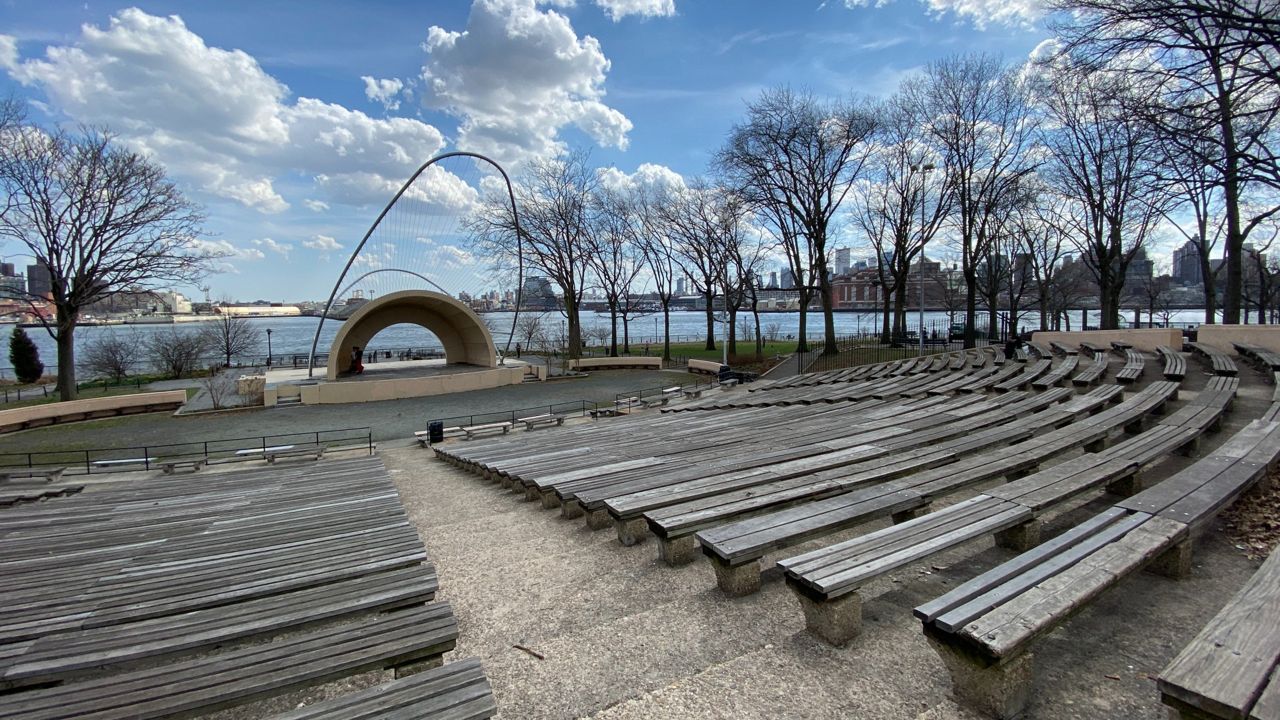Construction crews working on the project to rebuild East River Park have paused demolition on the park’s amphitheater after discovering asbestos at the site.
City officials said the asbestos is limited to a small sub-basement structure underneath the amphitheater that they did not know existed prior to demolition, and do not expect to find further contamination elsewhere in the park.
Yet the discovery of the asbestos comes after activists who have long opposed the project raised concerns about dust and other particulate matter that have been carried by wind from the construction area into the residential neighborhoods alongside the park.
Kathryn Freed, an attorney and former city councilwoman who is part of a group that has brought lawsuits against the city to stop the project, said her group does not believe the city was unaware of the asbestos in the structure. Asbestos is a known carcinogen.
“Of course they knew about it,” Freed said. “They don’t give a damn about the health and the welfare of the residents of this city.”
Shoshana Khan, a spokesperson for the city's Department of Design and Construction, said that workers had discovered the asbestos after demolition was nearly completed. Before tearing down the structure, construction crews took 13 materials samples from the amphitheater area, and found no traces of asbestos. A 2001 construction project at the site also did not uncover asbestos, Khan said.
“DDC and its contractors are working to remove the just-discovered asbestos quickly and safely,” Khan said. “DDC staff are ensuring there is no public access anywhere in the vicinity, and we will continue working to get this critical project done with the urgency it demands.”
The $1.5 billion reconstruction effort, which will see the park rebuilt on eight feet of fill so as to act as a barrier against storm surges, has been underway since last December, following delays caused by the pandemic and a lawsuit challenging the city’s authority to overhaul the park.
The project has been the subject of continued activist opposition, from groups and individuals who have faulted the project for requiring the destruction of nearly 1,000 mature trees in the park, as well as over transparency issues.
The rebuilt park, the city says, will provide a flooding barrier for more than 100,000 nearby residents of the Lower East Side, including tens of thousands of people in public housing developments, and make the park resistant to rising sea levels for decades.
The asbestos is located in insulation pipes beneath the amphitheater structure, which are not connected to existing city heating or water systems, or to other facilities in the parks, Dhanraj Damri, a construction manager with the Department of Design and Construction, which is overseeing the East River Park project, said at an Aug. 19 meeting of the community advisory group that monitors the project.
“They are contained to that specific area,” Damri said. “It’s not expected that it’s outside of that zone.”
The city has hired a licensed asbestos abatement contractor, who started work this week, Khan added. The abatement process could last into October.
Nancy Ortiz, a former president of the tenant association of the Vladeck Houses, a NYCHA development adjacent to the southern edge of the park, said she has not heard about the asbestos discovery or complaints from residents about the park construction.
She said that because the asbestos is purportedly confined to pipes, she is not concerned about the minerals becoming airborne.
"There's construction going on everywhere,” said Ortiz, who sits on the project’s community advisory group. “And you’re gonna get dust.”
John Keenan, a business agent for Local 78, a construction union, said he was not concerned about the asbestos because it was limited to underground pipes, and said he trusted the contractor on the job to handle the abatement process safely. Keenan said the contractor is using workers trained by his union.
“The city is pretty good with their testing procedures,” Keenan said. “And asbestos does pop up in unexpected places.”
A spokesperson for Councilwoman Carlina Rivera, who represents the area and has championed the construction effort — as well as campaigned on it this year in her unsuccessful bid for Congress — said she has asked for a public update from the city on the project.
“The East Side Coastal Resiliency project is an important and unprecedented effort and I’m dedicated to seeing it through with the oversight it demands so we can keep our frontline communities safe,” Rivera said in a statement provided by a spokesperson.
The asbestos discovery, however, has further frustrated the activists that oppose the project, who cite it as an example of what they have described as the city’s opacity around the project’s construction details.
“This is not the proper way that the city should react to its citizens. It’s just not,” Freed said. “What are we supposed to do, other than start another lawsuit, which may or may not result in anything?”
